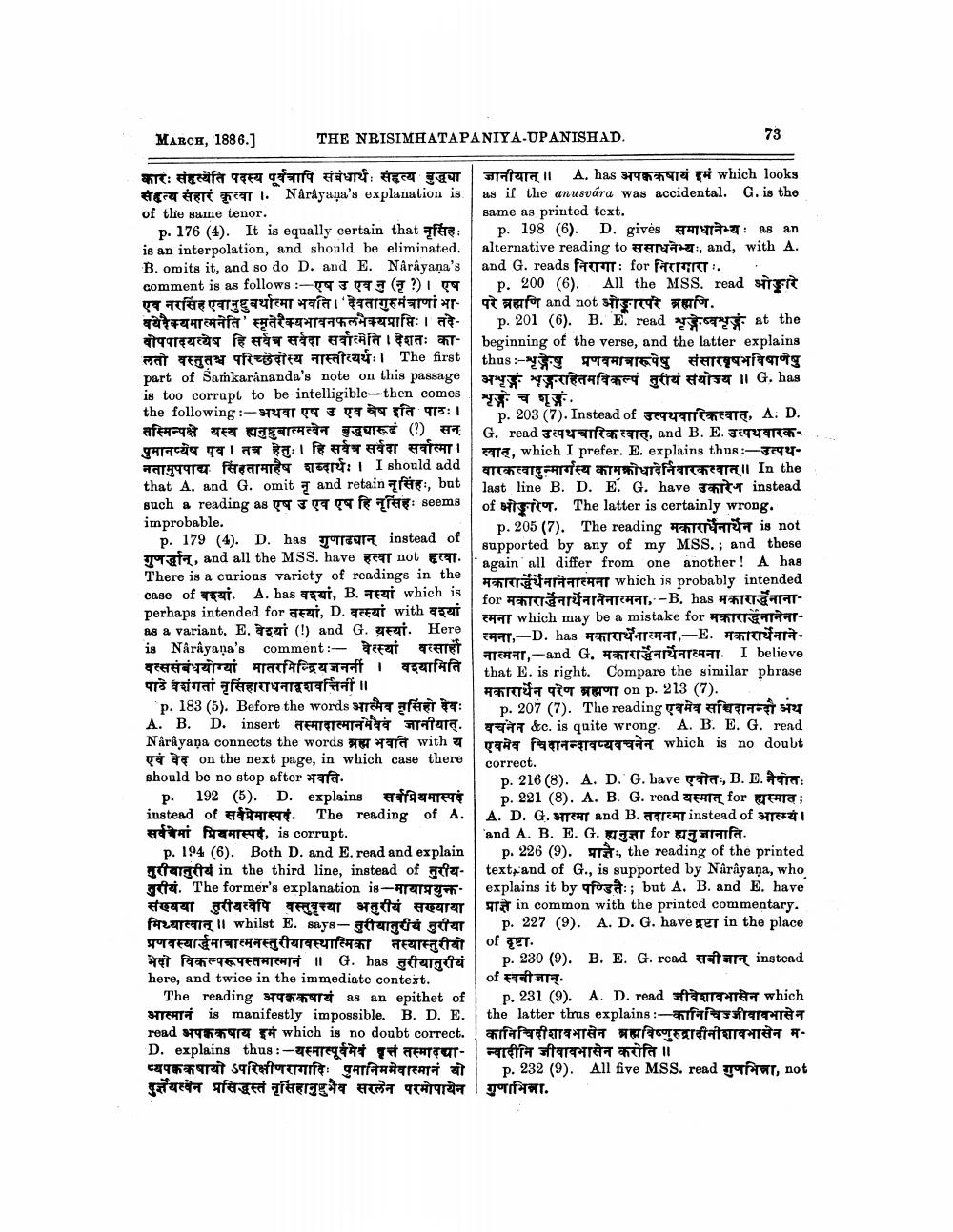________________
MARCH, 1886.]
THE NRISIMHATAPANIYA UPANISHAD.
78
कारः संहत्येति पदस्य पूर्वत्रापि संबंधार्थः संहत्य बुद्धचा जानीयात् ।। A. has अपक्ककषायं इमं which looks सहत्य संहारं कृत्वा | Narayapa's explanation is | as if the anusvara was accidental. G.is the of the same tenor.
same as printed text. p. 176(4). It is equally certain that नृसिंह: __p. 198 (6). D. gives समाधानेभ्यः as an is an interpolation, and should be eliminated. alternative reading to ससाधनेभ्यः , and, with A. B. omits it, and so do D. and E. Narayana's and G. reads निरागा: for निरागारा:. . comment is as follows:-एष उ एव न (नृ?)। एष | p.200 (6). All the MSS. read ओडारे एव नरसिंह एवानुष्टुबर्थात्मा भवति । देवतागुरुमंत्राणां भा- परे ब्रह्मणि and not ओङ्कारपरे ब्रह्मणि. वयरेक्यमात्मनेति' स्मृतेरैक्यभावनफलभैक्यप्राप्तिः । तदे. ___p. 201 (6). B. E. read श्रृजेष्वधृहं at the वोपपादयत्येष हि सर्वच सर्वदा सर्वात्मेति । देशतः का- beginning of the verse, and the latter explains लतो वस्तुतश्च परिच्छेदोस्य नास्तीत्यर्थः। The first
thus:-शृङ्गेषु प्रणवमात्रारूपेषु संसारवृषभविषाणेषु part of Samkarananda's note on this passage
अभृङ्ग अङ्गरहितमविकल्पं तुरीयं संयोज्य ॥ G. haa is too corrupt to be intelligible-then comes
शृङ्गे च शृङ्ग. the following:-अथवा एष उ एव वेष इति पाठः।
___p.203 (7). Instead of उत्पथवारिकत्वात, A. D. तस्मिन्पक्षे यस्य ह्यनुष्टुबात्मत्वेन बुद्धघारूढं (?) सन्
| G. read उत्पथचारिकरवात, and B. E. उत्पथवारकपुमानप्येष एव । तत्र हेतुः। हि सर्वत्र सर्वदा सर्वात्मा। त्वात्, which I prefer. E. explains thus:-उत्पथनतामुपपाद्य सिंहतामाहेष शब्दार्थः। I should add
वारकत्वादुन्मार्गस्य कामक्रोधादेनिवारकत्वात्।। In the that A. and G. omit नृ and retain नृसिंहः, but | last line B. D. E. G. have उकारे instead such a reading as एष उ एव एष हि नृसिंहः seems of it . The latter is certainly wrong. improbable.
p. 205 (7). The reading मकारार्धनार्थेन is not p. 179 (4). D. has गुणाढचान instead of
supported by any of my MSS.; and these गुणर्छन् , and all the MSS. have हत्या not हुरवा.
again all differ from one another ! A has There is a curious variety of readings in the
मकारार्थनानेनात्मना which is probably intended case of वश्यां . A. has वइयां, B. नस्यां which is
for मकारानार्थेनानेनारमना, -B. has मकारा नानाperhaps intended for तस्यां, D. वत्स्यां with वश्यां
स्मना which may be a mistake for मकारार्द्धनानेनाus a variant, E. वेश्यां (!) and G. यस्यां . Here
स्मना,-D. has मकारार्थेनात्मना,-E. मकारार्थेनानेis Nariyana's comment:- वेत्स्यां वत्साही
नात्मना,-and G. मकारार्द्धनार्थेनात्मना. I believe वत्ससंबंधयोग्यां मातरमिन्द्रियजननी । वश्यामिति
that E. is right. Compare the similar phrase पाठे वैशंगतां नृसिंहाराधनावशवत्तिनीं ।।
मकारार्थेन परेण ब्रह्मणा on p. 213 (7). . p. 183 (5). Before the words आत्मैव नृसिंहो देवः p. 207 (7). The reading एवमेव सच्चिदानन्दौ अंथ A. B. D. insert तस्मादात्मानमेववं जानीयात्. वचनेन &c. is quite wrong. A. B. E. G. read Narayana connects the words ब्रह्म भवति with य एवमेव चिदानन्दावयवचनेन which is no doubt एवं वेद on the next page, in which case there
correct. should be no stop after भवति.
p.216 (8). A. D. G. have एवोतः, B. E. नैवोतः p. 192 (6). D. explains सर्वप्रियमास्पदं p.221 (8). A. B. G. read यस्मात् for ह्यस्मात; instead of सर्वप्रेमास्पद. The reading of A. | A. D. G.आरमा and B. तदात्मा instead of आत्म्यं । सर्वमा भिवमास्पद, is corrupt.
and A. B. E.G. ह्यनुज्ञा for ह्यनुजानाति. p. 194 (6). Both D. and E. read and explain | p. 226 (9). प्राज्ञैः, the reading of the printed नुरीबातुरीयं in the third line, instead of तुरीय- | texty-and of G., is supported by Narayana, who वरीयं. The former's explanation is-मायाप्रयुक्त explains it by yoga:; but A. B. and E. have
संख्यया तुरीयत्वेपि वस्तुवृत्या अतुरीयं सख्याया | प्राज्ञे in common with the printed commentary. मिथ्यात्वात् || whilst E. Bays-तुरीयातुरीयं तुरीया | p.227 (9). A. D.G. have द्रष्टा in the place प्रणवस्यार्द्धमात्रात्मनस्तुरीयावस्थात्मिका तस्यास्तुरीयो | of दृष्टा. भेती विकल्परूपस्तमात्मानं ॥ G. has तुरीयातुरीयं p. 230 (9). B.E. G. read सबीजान instead here, and twice in the immediate context. of स्वबीजान्.
The reading अपककषायं as an epithet of | p. 231 (9). A. D. read जीवेशावभासेन which आस्मानं is manifestly impossible. B. D. E. | the latter thrus explains:-कानिचिज्जीवावभासेन read अपककषाय इमं which is no doubt correct. ! कानिचिदीशावभासेन ब्रह्मविष्णुरुद्रादीनीशावभासेन म. D. explains thus:-यस्मात्पूर्वमेवं वृत्तं तस्मादद्या- | न्वादीनि जीवावभासेन करोति ।। प्यपककषायो ऽपरिक्षीणरागादिः पुमानिममेवात्मानं यो| p.232 (9). All five MSS. read गुणभिन्ना, not पुर्जेयत्वेन प्रसिद्धस्तं नृसिंहानुष्टुभैव सरलेन परमोपायेन | गुणाभिमा.




